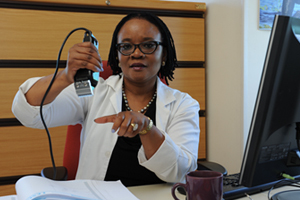Bring your own clippers: Health risks of the chiskop haircut
09 January 2014 | Story by Newsroom
A public education programme is urgently needed to warn clients of the risks of inadequately sterilised barber equipment, particularly those who opt for the clean-shaved haircut known colloquially as the chiskop.
Professor Nonhlanhla Khumalo, head of dermatology, said clients should be encouraged to have their own hair clippers and to ask barbers to use these.
Khumalo conducted two studies on health risks of chiskop. The haircut is rare among women but popular with black South African men who are also predisposed to folliculitis keloidalis nuchae, or keloids, on the back of the head.
Haircut-associated bleeding affects at least one quarter of African men who shave their heads. Khumalo's studies also advocate future investigations into potential HIV and Hepatitis B transmission through clean-shave haircuts.
A cut above
During a previous population study in Langa in the Western Cape, participants noted an unexpected symptom of haircut-associated bleeding. A question directed to the last 170 participants in that study revealed that 32% of the participants had a history of haircut-associated bleeding and the prevalence of keloids was 10.5%.
This had prompted Khumalo's first study on health risks associated with the chiskop haircut, the results of which were published in the South African Medical Journal last July.
"As 'haircut-associated bleeding' is not a widely recognised entity, we conducted this study at an HIV clinic servicing the same population in Langa, with the objective of comparing the prevalence of haircut-associated bleeding and folliculitis keloidalis nuchae in 390 HIV-positive people with the data previously published for Langa," said Khumalo.
The results for HIV-positive participants were similar to the population data (prevalence of folliculitis keloidalis nuchae 10% and history of haircut-associated bleeding 24.5%). In both studies the prevalence of haircut-associated bleeding was much higher than that of folliculitis keloidalis nuchae, suggesting that the hairstyle increases the risk of bleeding, even in people with healthy scalps without folliculitis.
Risky business
"This study does not '“ and was not intended to '“ prove a higher HIV prevalence in chiskop wearers or in folliculitis keloidalis nuchae sufferers, but it confirms a history of haircut-associated bleeding in at least a quarter of our male study participants," added Khumalo. "The risk of transmission of blood-borne infection via haircuts is likely to be low, but requires formal quantification."
The latest research, published in the journal Dermatology in October, was a pilot study conducted in collaboration with the Departments of Genetics, Virology and Human Biology. The study aimed to elucidate whether invisible haircut-associated bleeding was detectable using blood-specific Ribonucleic acid (RNA) markers (involving 16 participants, five with unknown HIV status) and whether surface viruses could be detected using genetic testing from scalp swabs (of 11 known HIV-positive participants).
Haircuts were performed professionally, while scalps were examined by a dermatologist to exclude injury and then swabbed for testing. Blood samples for serum human immunodeficiency (HI) viral loads were collected at the same time.
Close shave
Khumalo says in all, six out of 16 samples tested positive for haemoglobin beta and albumin, confirming evidence of bleeding. Only one of the 11 HIV-positive participants had detectable scalp bleeding, but had an undetectable serum HI viral load.
This may explain why no-surface HIV was detected from scalp samples. This study confirms the entity of haircut-associated bleeding, but also goes further '“ showing for the first time that invisible bleeding from clean-shave haircuts is also common.
"We do not know how big or small the risk of HIV transmission through haircut-associated bleeding is. However, it is reasonable to protect everyone from coming into contact with infected blood, particularly when having a haircut that we now know increases the risk of both visible and invisible injury," she said.
"The simple message is, if you wear a chiskop haircut make sure your barber uses a steriliser or (clearly labelled) antiviral spray on clippers; methylated spirits is not enough. Otherwise take your own clipper for him to use. Until further scientific evidence is available, it may be prudent to promote (sterilisation and/or) individual-clipper-ownership for chiskops".
Khumalo said she was discussing sterilisation standards with the Services Sector Education and Training Authority under which the hairdressing industry falls.
Staff reporter. Image by Michael Hammond.
 This work is licensed under a Creative Commons Attribution-NoDerivatives 4.0 International License.
This work is licensed under a Creative Commons Attribution-NoDerivatives 4.0 International License.
Please view the republishing articles page for more information.










